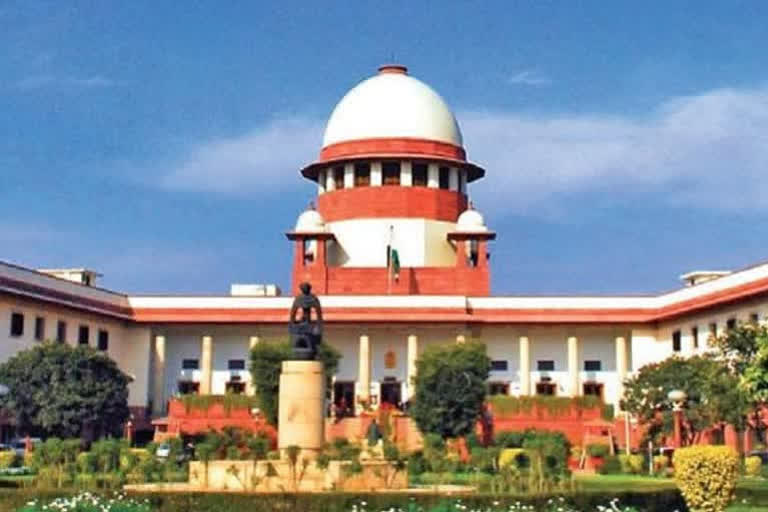Hyderabad: In India, there are 15000 courts housed in 2500 complexes, and it was in 1990 that they were equipped with technology. Until 2003 or 2006, not many changes had been achieved though there has been speculation and scepticism over the use of technology. However, Section 65A and 65B of the Indian Evidence Act, 1872, allowed for a special provision of an electronic record. This also enabled video conferencing to be allowed in courts.
Also read: Demonetised currency notes worth Rs 4.8 cr seized in Tamil Nadu
During the coronavirus induced lockdown, even courts were badly affected. As justice cannot be delayed in a constitutional democracy, the Supreme Court rose to the occasion. It heard over 15,000 matters via video conferencing since March 23, 2020, when a lockdown was announced in the wake of the pandemic.
What's the way ahead?
Virtual hearings put forward in the Supreme Court face technical issues with judges having expressed their unhappiness over various apps. To sort out this issue, the NIC and Union Law Ministry is working out modalities of virtual hearings. This has led to a situation wherein a need for a common platform to connect all courts with litigants is much awaited.
A few months earlier, Attorney General KK Venugopal had requested the court to start the live proceedings of court hearings. On the other hand, when courts were held virtually, around 40% of jails in the nation lacked video conferencing facilities. According to the report by TATA Trusts, only 60% of the jails had video conferencing facilities.
Also read: Tejashwi hits out at Nitish govt over 'poor health infrastructure'
India's Supreme Court directed in April 2020 that court proceedings be conducted via video-conferencing to minimise physical appearances and enable social distancing. However, India's justice systems were not fully equipped to deal with the emergency, the India Justice Report, 2020 finds. In its second edition, IJR 2020, two new indicators on the incorporation of technology- video-conferencing facilities in jails and accessibility of state online citizen portals, were prompted.
IJR 2020 had analysed 25 states and UTs' progress on 53 indicators, which include - budget allocations and utilisation; infrastructure and human resources; workload including case pendency; and diversity in the police, judiciary, prison and legal aid systems. Data for the remaining states and UTs were also provided, but not included in the rankings. Among the 18 larger states, Maharashtra was adjudged the best and UP as the worst in delivering justice.
Also read: Hardcore Maoist Kolha Yadav held in Bihar: Jharkhand police
The Rule of Law Index 2020 ranked India 69th among 128 countries, below Sri Lanka and Nepal. India was also ranked among the bottom 25 of 163 countries in the Global Peace Index 2020, despite ascending two ranks, when global peace took a downturn due to the Covid-19 pandemic. This placed India below Bhutan (19), Nepal (73), Sri Lanka (77) and Bangladesh (97).
Video-conferencing and online citizen portals
The Supreme Court's guidelines with respect to using video conferencing apps in the apex court, High Courts and district courts was to ensure the continued dispensation of justice while staying safe from the COVID-19 pandemic. It was only later that an amendment was made to the Code of Criminal Procedure which allowed video conferencing for prescribed proceedings, including as an alternative to producing accused persons in court.
Also read: French Foreign Minister Le Drian arrives in India
However, only Haryana and Uttarakhand had video conferencing facilities in all their jails as of December 2019, according to IJR 2020. Tamil Nadu had the lowest proportion of jails with these facilities, at 9%, followed by Karnataka (31%), West Bengal (32%), Rajasthan (38%) and Kerala (42%).
Among other states and UTs, Arunachal Pradesh, Goa, Himachal Pradesh, Assam, Chandigarh, Dadra & Nagar Haveli, Delhi and Puducherry had video conferencing facilities in all jails, while Daman and Diu, Lakshadweep, Mizoram, Nagaland and Sikkim had no video conferencing facilities.
Also read: Judge who gave Babri case verdict is appointed 'up-lokayukta'
In addition to video conferencing, online citizen portals were launched to provide basic services, such as filing and tracking complaints, reporting of lost vehicles and property, and applying for various verifications and permissions.
While most of the states except Bihar have online citizen portals, many of them do not work or require specific internet browsers or were not available in local languages. The state portals of Punjab and Himachal Pradesh got the maximum points for their portals' accessibility, completeness of services offered and for native language option other than English.



